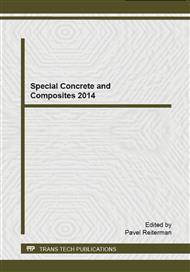p.17
p.22
p.27
p.33
p.37
p.43
p.48
p.54
p.58
Usage of Heat Pretreatment for Reduction of Explosive Spalling of High Performance Concrete
Abstract:
Fire resistance of concrete structures could be improved by add of polypropylene fibres in to the concrete mixture in butch from 1 to 2 kg per 1 m3 of fresh concrete. This method is effective, but it is not possible to use it for existing concrete and existing reinforced concrete structures. The new method which has good potential for fire protection of existing structures is based on creation of capillary pore and micro cracks system, which allowed water vapour evaporate from concrete. This study deals with determination of appropriate temperature in which is created adequate network of capillary pores and micro cracks which has no influence on strength and durability of the concrete. The formation of macro cracks and bigger pores could cause rapid reduction of compressive and tensile strength, decrease of resistance to aggressive substances and decrease of the frost resistance. The high performance concrete (HPC) has very low porosity, which can cause explosive spalling while the water vapour tries to evaporate from concrete structure during the fire. The HPC concrete has high compressive strength and high density. The HPC samples were exposed to temperatures 150, 250, 350 a 450°C, and after cooling down to normal ambient were carried out tests to define changes in porosity by mercury porosimetry, mass looses and compressive strength changes. The heated HPC concrete is regaining humidity into its structure from surrounding atmosphere, which can cause rehydratation of some chemical compounds. [1] For verification of these hypotheses the HPC samples were kept in water storage for 4 weeks and then tested.
Info:
Periodical:
Pages:
37-42
Citation:
Online since:
October 2014
Authors:
Price:
Сopyright:
© 2014 Trans Tech Publications Ltd. All Rights Reserved
Share:
Citation:


